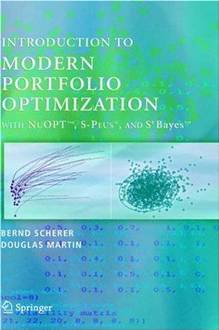Introduction to Modern Portfolio Optimization
Scherer, Bernd / Martin, R. Do
Éditeur : SPRINGER NATURE
ISBN papier: 387210164
Parution : 2006
Code produit : 1270961
Catégorisation :
Livres /
Gestion /
Finance /
Gestion de portefeuille
Formats disponibles
| Format | Qté. disp. | Prix* | Commander |
|---|---|---|---|
| Livre papier | En rupture de stock** |
Prix membre : 93,05 $ Prix non-membre : 97,95 $ |
*Les prix sont en dollars canadien. Taxes et frais de livraison en sus.
**Ce produits est en rupture de stock mais sera expédié dès qu'ils sera disponible.
Description
In recent years portfolio optimization and construction methodologies have become an increasingly critical ingredient of asset and fund management, while at the same time portfolio risk assessment has become an essential ingredient in risk management, and this trend will only accelerate in the coming years. Unfortunately there is a large gap between the limited treatment of portfolio construction methods that are presented in most university courses with relatively little hands-on experience and limited computing tools, and the rich and varied aspects of portfolio construction that are used in practice in the finance industry. Current practice demands the use of modern methods of portfolio construction that go well beyond the classical Markowitz mean-variance optimality theory and require the use of powerful scalable numerical optimization methods. This book fills the gap between current university instruction and current industry practice by providing a comprehensive computationally-oriented treatment of modern portfolio optimization and construction methods. The computational aspect of the book is based on extensive use of S-Plus®, the S+NuOPT™ optimization module, the S-Plus Robust Library and the S+Bayes™ Library, along with about 100 S-Plus scripts and some CRSP® sample data sets of stock returns. A special time-limited version of the S-Plus software is available to purchasers of this book. “For money managers and investment professionals in the field, optimization is truly a can of worms rather left un-opened, until now! Here lies a thorough explanation of almost all possibilities one can think of for portfolio optimization, complete with error estimation techniques and explanation of when non-normality plays a part. A highly recommended and practical handbook for the consummate professional and student alike!” Steven P. Greiner, Ph.D., Chief Large Cap Quant & Fundamental Research Manager, Harris Investment Management “The authors take a huge step in the long struggle to establish applied post-modern portfolio theory. The optimization and statistical techniques generalize the normal linear model to include robustness, non-normality, and semi-conjugate Bayesian analysis via MCMC. The techniques are very clearly demonstrated by the extensive use and tight integration of S-Plus software. Their book should be an enormous help to students and practitioners trying to move beyond traditional modern portfolio theory.” Peter Knez, CIO, Global Head of Fixed Income, Barclays Global Investors “With regard to static portfolio optimization, the book gives a good survey on the development from the basic Markowitz approach to state of the art models and is in particular valuable for direct use in practice or for lectures combined with practical exercises.” Short Book Reviews of the International Statistical Institute, December 2005























